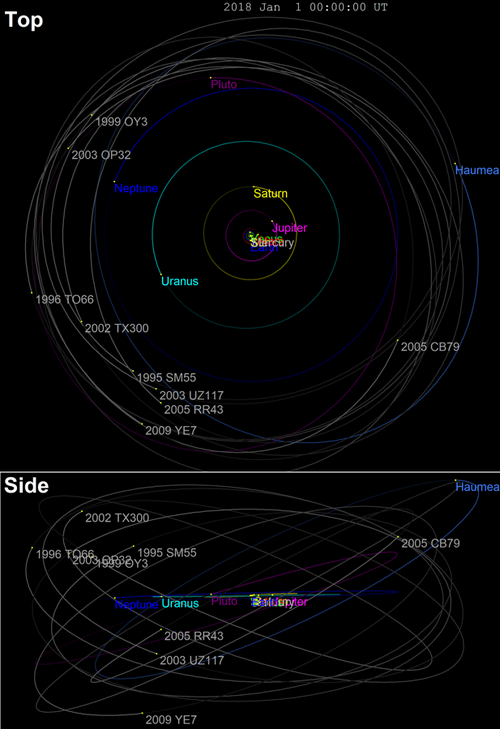Astronomy:(24835) 1995 SM55
| Discovery[1][2] | |
|---|---|
| Discovered by | N. Danzl |
| Discovery site | Spacewatch Kitt Peak National Obs. |
| Discovery date | 19 September 1995 |
| Designations | |
| (24835) 1995 SM55 | |
| 1995 SM55 | |
| Minor planet category | TNO[1] · Haumea[3] · cubewano[4][5] Scat-Ext[6] · distant[2] |
| Orbital characteristics[1] | |
| Epoch 4 September 2017 (JD 2458000.5) | |
| Uncertainty parameter 3 | |
| Observation arc | 34.29 yr (12,523 days) |
| |{{{apsis}}}|helion}} | 45.870 AU |
| |{{{apsis}}}|helion}} | 37.386 AU |
| 41.628 AU | |
| Eccentricity | 0.1019 |
| Orbital period | 268.59 yr (98,101 days) |
| Mean anomaly | 329.45° |
| Mean motion | 0° 0m 13.32s / day |
| Inclination | 27.096° |
| Longitude of ascending node | 21.109° |
| |{{{apsis}}}|helion}} | ≈ 7 June 2040[7] ±5 days |
| 72.600° | |
| Physical characteristics | |
| Mean diameter | 173 km (estimate)[3] 519.43 km (derived)[8] 610 km (Haumea-derived)[9] 701 km[4] 704 km (upper limit)[10][11] |
| Rotation period | 8.08±0.02 h[12] 8.08±0.03 h[13] |
| Geometric albedo | 0.7 (Haumea-derived)[3] 0.040[4] 0.067 (at least)[10] 0.10 (assumed)[8] |
| BBb (suspected)[14] · C[8] (Neutral) B–V = 0.65[8] V−R = 0.37[8] V−I = 0.710[8] | |
| Absolute magnitude (H) | 4.30±0.02 (R)[15] 4.352±0.040 (R)[16] 4.490±0.030[17] 4.54[8][18] · 4.6[1] · 4.9[3] |
(24835) 1995 SM55 (provisional designation 1995 SM55) is a trans-Neptunian object and member of the Haumea family that resides in the Kuiper belt, located in the outermost region of the Solar System. It was discovered on 19 September 1995, by American astronomer Nichole Danzl of the Spacewatch program at Kitt Peak National Observatory near Tucson, Arizona, in the United States.[2] It measures approximately 200 kilometers in diameter and was the second-brightest known object in the Kuiper belt, after Pluto, until 1996 TO66 was discovered.
Origin
1995 SM55 is a member of the Haumea family.[3] It has the highest collisional velocity, a δv of 123.3 m/s, of all confirmed members.[19] Based on their common pattern of IR water-ice absorptions, neutral visible spectrum[20] and the clustering of their orbital elements, the other KBOs 1996 TO66, 2002 TX300, 2003 OP32 and 2005 RR43 all appear to be collisional fragments broken off of the dwarf planet Haumea.
Naming
As of 2018, this minor planet has not been named by the Minor Planet Center.[2]
Orbital diagram
References
- ↑ 1.0 1.1 1.2 1.3 "JPL Small-Body Database Browser: 24835 (1995 SM55)". Jet Propulsion Laboratory. https://ssd.jpl.nasa.gov/sbdb.cgi?sstr=2024835. Retrieved 8 February 2018.
- ↑ 2.0 2.1 2.2 2.3 "24835 (1995 SM55)". Minor Planet Center. https://www.minorplanetcenter.net/db_search/show_object?object_id=24835. Retrieved 8 February 2018.
- ↑ 3.0 3.1 3.2 3.3 3.4 Michael E. Brown. "How many dwarf planets are there in the outer solar system?". California Institute of Technology. http://web.gps.caltech.edu/~mbrown/dps.html. Retrieved 8 February 2018.
- ↑ 4.0 4.1 4.2 Johnston, Wm. Robert (15 October 2017). "List of Known Trans-Neptunian Objects". Johnston's Archive. http://www.johnstonsarchive.net/astro/tnoslist.html. Retrieved 8 February 2018.
- ↑ "MPEC 2009-R09 :Distant Minor Planets (2009 SEPT. 16.0 TT)". IAU Minor Planet Center. 2009-09-04. http://www.cfa.harvard.edu/mpec/K09/K09R09.html. Retrieved 2009-10-04.
- ↑ Marc W. Buie. "Orbit Fit and Astrometric record for 24835". SwRI (Space Science Department). http://www.boulder.swri.edu/~buie/kbo/astrom/24835.html. Retrieved 2009-10-04.
- ↑ JPL Horizons Observer Location: @sun (Perihelion occurs when deldot changes from negative to positive. Uncertainty in time of perihelion is 3-sigma.)
- ↑ 8.0 8.1 8.2 8.3 8.4 8.5 8.6 "LCDB Data for (24835)". Asteroid Lightcurve Database (LCDB). http://www.minorplanet.info/PHP/generateOneAsteroidInfo.php?AstInfo=24835%7C. Retrieved 8 February 2018.
- ↑ "Asteroid Size Estimator". CNEOS NASA/JPL. https://cneos.jpl.nasa.gov/tools/ast_size_est.html. Retrieved 8 February 2018.
- ↑ 10.0 10.1 Grundy, W. M.; Noll, K. S.; Stephens, D. C. (July 2005). "Diverse albedos of small trans-neptunian objects". Icarus 176 (1): 184–191. doi:10.1016/j.icarus.2005.01.007. Bibcode: 2005Icar..176..184G.
- ↑ John Stansberry; Will Grundy; Mike Brown; Dale Cruikshank; John Spencer; David Trilling et al. (2007). Physical Properties of Kuiper Belt and Centaur Objects: Constraints from Spitzer Space Telescope. Bibcode: 2008ssbn.book..161S.
- ↑ Thirouin, Audrey; Sheppard, Scott S.; Noll, Keith S.; Moskovitz, Nicholas A.; Ortiz, Jose Luis; Doressoundiram, Alain (June 2016). "Rotational Properties of the Haumea Family Members and Candidates: Short-term Variability.". The Astronomical Journal 151 (6): 20. doi:10.3847/0004-6256/151/6/148. Bibcode: 2016AJ....151..148T.
- ↑ Sheppard, Scott S.; Jewitt, David C. (June 2003). "Hawaii Kuiper Belt Variability Project: An Update". Earth, Moon, and Planets 92 (1): 207–219. doi:10.1023/B:MOON.0000031943.12968.46. Bibcode: 2003EM&P...92..207S.
- ↑ Belskaya, Irina N.; Barucci, Maria A.; Fulchignoni, Marcello; Dovgopol, Anatolij N. (April 2015). "Updated taxonomy of trans-neptunian objects and centaurs: Influence of albedo". Icarus 250: 482–491. doi:10.1016/j.icarus.2014.12.004. Bibcode: 2015Icar..250..482B.
- ↑ Jewitt, David; Peixinho, Nuno; Hsieh, Henry H. (November 2007). "U-Band Photometry of Kuiper Belt Objects". The Astronomical Journal 134 (5): 2046–2053. doi:10.1086/522787. Bibcode: 2007AJ....134.2046J.
- ↑ Peixinho, N.; Delsanti, A.; Guilbert-Lepoutre, A.; Gafeira, R.; Lacerda, P. (October 2012). "The bimodal colors of Centaurs and small Kuiper belt objects". Astronomy and Astrophysics 546: 12. doi:10.1051/0004-6361/201219057. Bibcode: 2012A&A...546A..86P.
- ↑ Rabinowitz, David L.; Schaefer, Bradley E.; Schaefer, Martha; Tourtellotte, Suzanne W. (October 2008). "The Youthful Appearance of the 2003 EL61 Collisional Family". The Astronomical Journal 136 (4): 1502–1509. doi:10.1088/0004-6256/136/4/1502. Bibcode: 2008AJ....136.1502R.
- ↑ Romanishin, W.; Tegler, S. C. (December 2005). "Accurate absolute magnitudes for Kuiper belt objects and Centaurs". Icarus 179 (2): 523–526. doi:10.1016/j.icarus.2005.06.016. Bibcode: 2005Icar..179..523R.
- ↑ Snodgrass, C.; Carry, B.; Dumas, C.; Hainaut, O. (February 2010). "Characterisation of candidate members of (136108) Haumea's family". Astronomy and Astrophysics 511: 9. doi:10.1051/0004-6361/200913031. Bibcode: 2010A&A...511A..72S.
- ↑ Pinilla-Alonso, N.; Licandro, J.; Gil-Hutton, R.; Brunetto, R. (June 2007). "The water ice rich surface of (145453) 2005 RR43: a case for a carbon-depleted population of TNOs?". Astronomy and Astrophysics 468 (1): L25. doi:10.1051/0004-6361:20077294. Bibcode: 2007A&A...468L..25P.
External links
- List of Transneptunian Objects, Minor Planet Center
- (24835) 1995 SM55 at AstDyS-2, Asteroids—Dynamic Site
- (24835) 1995 SM55 at the JPL Small-Body Database
 |



